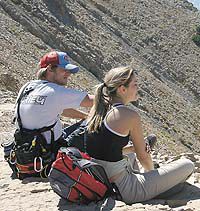| Two hikers pause for a rest before pursuing the climb farthur up a trail. Many people like to spend time at high altitudes during the summer, and protection from the sun and plenty of water can make the experience much more enjoyable. |
The word summer brings out all kinds of images for people.
Some see bright days, while others can only think of blinding heat. Others think of lush meadows in the mountains, while some can only think of the mosquitoes and bugs that lurk among the foliage. Some have images of playing in the water, while others can only remember a tragedy associated with it.
Summertime is a two sided sword. It is the time that people love to get outdoors and do all kinds of things. It is also the time that health problems and accidents can make life miserable, and often both of those are a result of someone not being careful or taking precautions.
Each year it seems some new threat to our health emerges from the summer season. Two years ago it was West Nile Disease, this year it is the possibility that migrating birds could bring the bird flu to our country. Regardless of any new threats however, many of the old ones remain and continue to plague the population.
While all the health problems associated with summer’s can be serious, probably over the years the one that most gathers peoples interest are those maladies having to do with heat and the sun. In recent years researchers have learned that one good sunburn as a child can increase the risk of skin cancer years later. That information does the greatest generation, the baby boomers and generation X little good in terms of early prevention, but it can prevent children from facing such an uncertain future.
A sunburn results from too much sun or some kind of exposure like the sun. That means people can get sunburn like symptoms from a tanning bed, from arch welding or from many other sources. Everyone who goes outdoors and does anything will get a sunburn at one time or another.
A sunburn is a burn on the skin, somewhat like a person would get if they touched a hot stove burner or stuck their hand in a fire. And very bad sunburns can be nearly as serious too.
A sunburn comes from ultraviolet (UV) radiation. The result of this burn is an inflammation of the skin and the injury can start with only a few minutes of exposure.
There are actually two kinds of UV radiation, UVA and UVB. UVB radiation is more damaging to the skin especially for skin cancer. Both UVA and UVB can bring on wrinkles and aged skin prematurely.
There are certain places where skin damage can occur more quickly. The southeastern and southwestern United States are very sunny, hot regions. In the local area, high altitude can also be particularly damaging.
| Fair haired, fair skinned people are more susceptible to sunburn. |
There are also benefits to being exposed to the sun, in fact some researchers have recently voiced concerns about the fact many people are protecting themselves too much from the solar rays. UV radiation produces vitamin D in the skin which is important to the body. The best thing for most people is to practice moderation when placing their bodies in the sun.
Of course the best prevention for sunburn and the possible problems associated with it is to avoid the sun. Obviously, if one wants to live an active lifestyle this is almost impossible.
There are many more practical things people can do. This includes wearing wide-brimmed hats (not caps because they don’t cover the ears or neck), long-sleeved shirts, and long pants. Obviously, wearing long sleeves are something few people want to do in hot weather. So there are other answers.
Probably the most popular are the variety of sun-blocking agents that are available for use. Some kinds are just for the face. Others can be used on other parts of the body. The sun protection factor (SPF) is something anyone using sun block should pay attention to. The higher the SPF number, the more protection the sun-blocking agent should have.
The SPF is actually the ratio of the time it takes to produce a skin change on protected and unprotected skin. For instance a 30 SPF sunscreen should protect the skin from the suns rays 30 times longer than no protection. However the rating should not be applied as exact, because no sun blockers would do that.
One of the problems with sunscreen is that people forget to reapply once they have it on, or they may not even use enough to begin with. Think of sun screen the same way that clothes are used to keep one warm during the cold months. Layering is good and will give a person more protection.
There are things that take away a sunscreen’s effectiveness. Getting in water is one. It washes away, regardless of what the labels say. In fact the United States Food and Drug Administration is trying to get many of the claims that some sunblock manufacturers removed from the packaging. Besides waterproof, others they object to are sunblock (which means it would block out the sun rather than screen it) and all day protection.
Certain people are more sensitive to the sun than others too. Fair haired, fair skinned people burn easier. Those taking certain kinds of drugs can also be affected more by the sun than others. Things like acne medications and some antibiotics are good examples.
Some people believe that once a person has had enough short exposures to the sun (which creates tanning) they are safe to be exposed more. While tanning can lead to increased sun tolerance, it can also lead to long term skin problems like creating leathery skin and eventually skin cancer.

